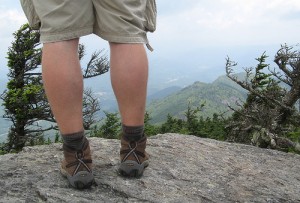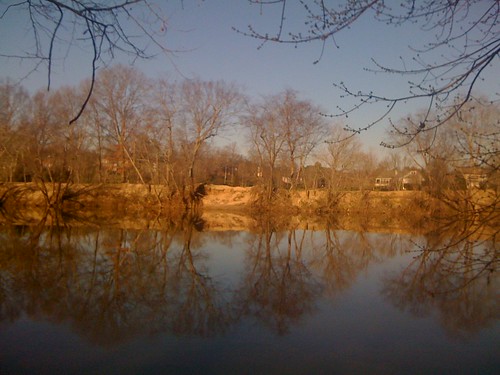Pictures from Tanglewood Festival of Lights 2013 23 Nov 2013 8:31 AM (11 years ago)
Every November, the organizers of the Tanglewood Festival of Lights allow a walk-through so folks can take their time and immerse themselves in the riot of holiday lighting. That happened last night; tonight the festival begins in earnest with carloads of people inching their way through the park.
Few will ever leave their cars, which is a shame because putting a two-ton vehicle between yourself and all this is a crime against the senses. It was a bit misty and far too warm to qualify as wintry weather on Friday night, but the ability to feel the breezes, move at whatever pace feels comfy, pause to take pictures and hear the kids erupting in peals of joy was priceless.
In comparison, driving through the festival in a car feels more like standing in line at Disneyland. While you get the thrills eventually, the crowds and the waiting ruin the magic.
I’m guessing no more than a few hundred people showed up last night, but those of us who made it were in for a treat. Note that I have no claims to moral superiority for walking through this year; I’ve had the same opportunity for the past three years and never managed to dislodge my fanny from my favorite chair in front of the TV.
Here’s a quick summary of last night’s walk-through, posted in the order I took the photos.
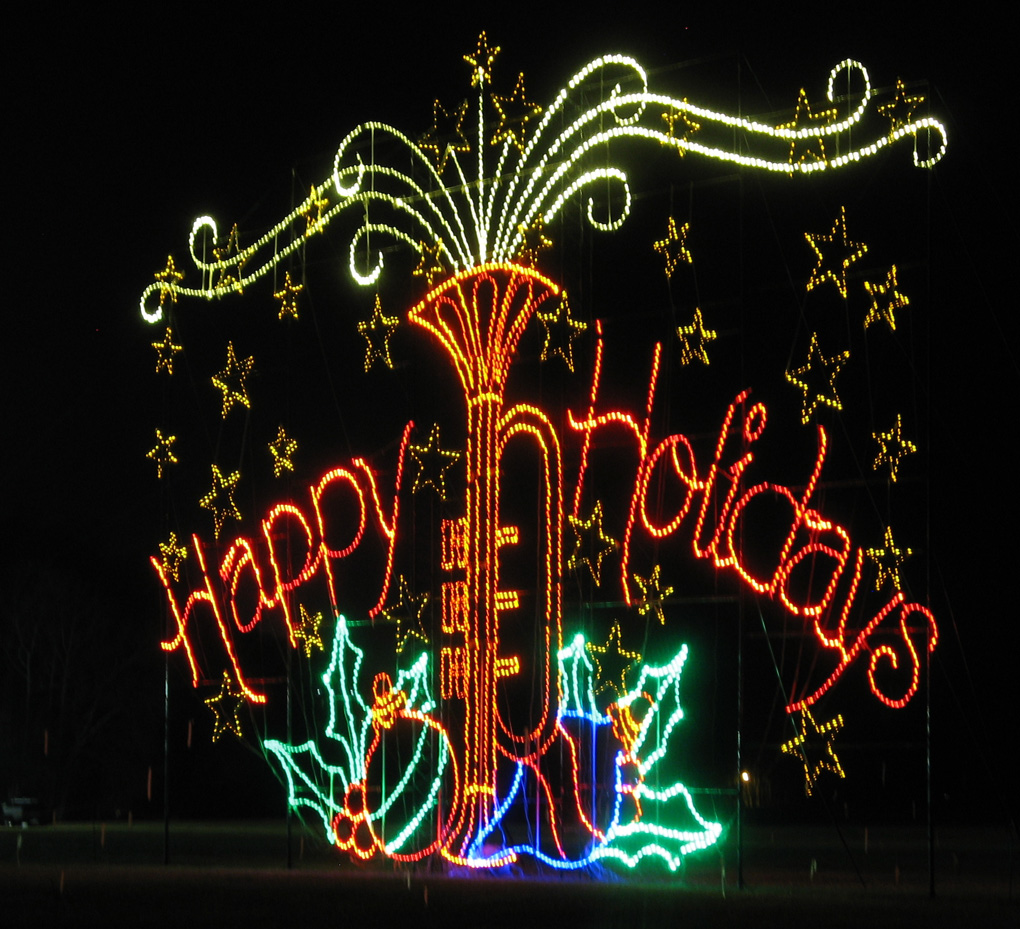
From a shutterbug’s perspective, the best thing about the walk-through is the ability to get close to the displays; there’s not much chance of that in a car. When you’re up close, there’s enough light for the camera to get at least a decent handheld shot at a one-eighth-second exposure. The camera’s image-stabilization technology does the rest.
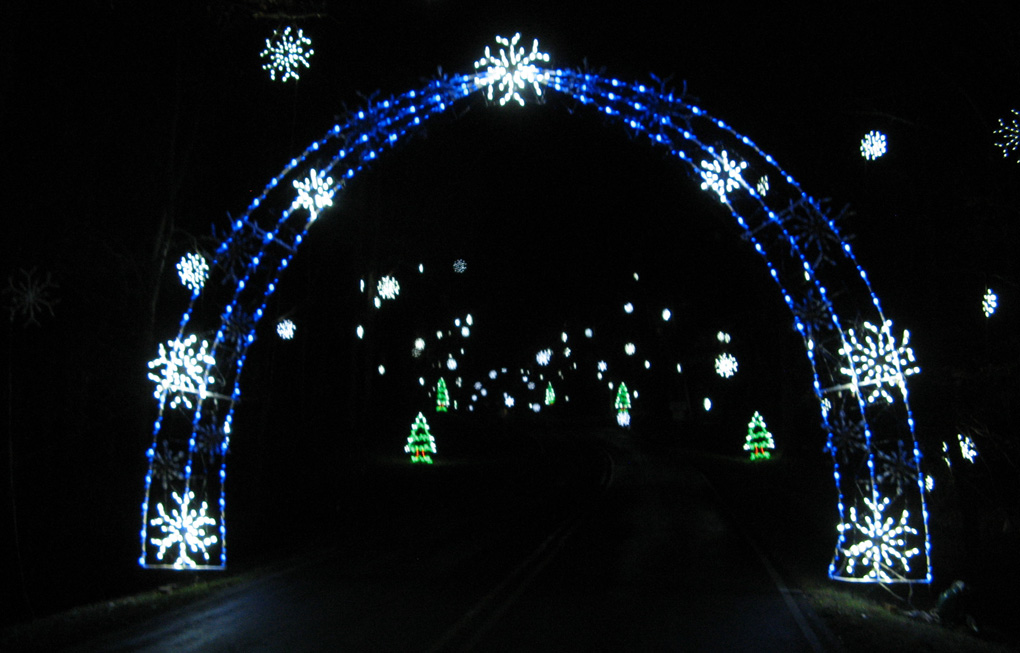
This is the first big feature after you enter the festival. All these snowflakes are flickering, which gives the visual centers of the brain a nice workout.
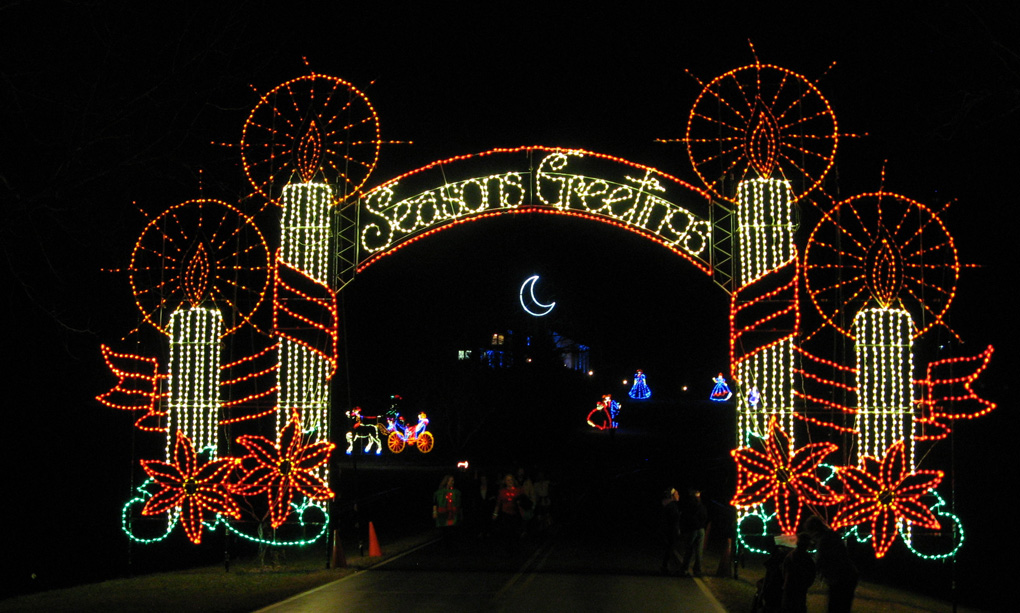
Probably one of the best scenes in the festival. A lot of the festival’s lighting is over-the-top but this one has a subtlety that better reflects the spirit of the season, as we like to say.
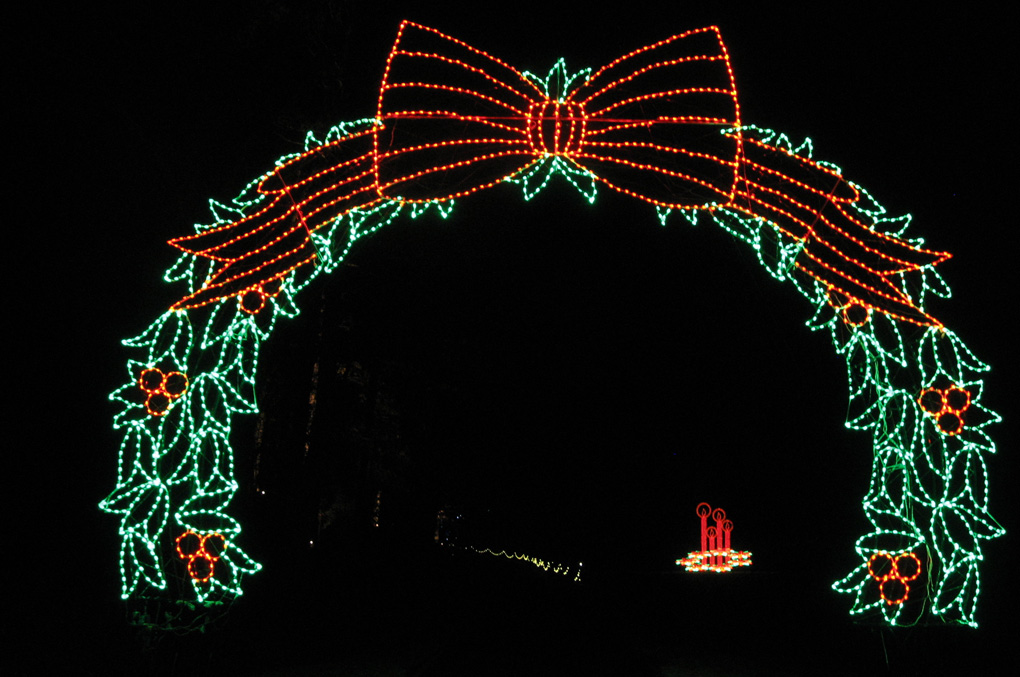
The abundance of arches over the road speaks to the fact that this is designed to be seen through the front windshield of a car.
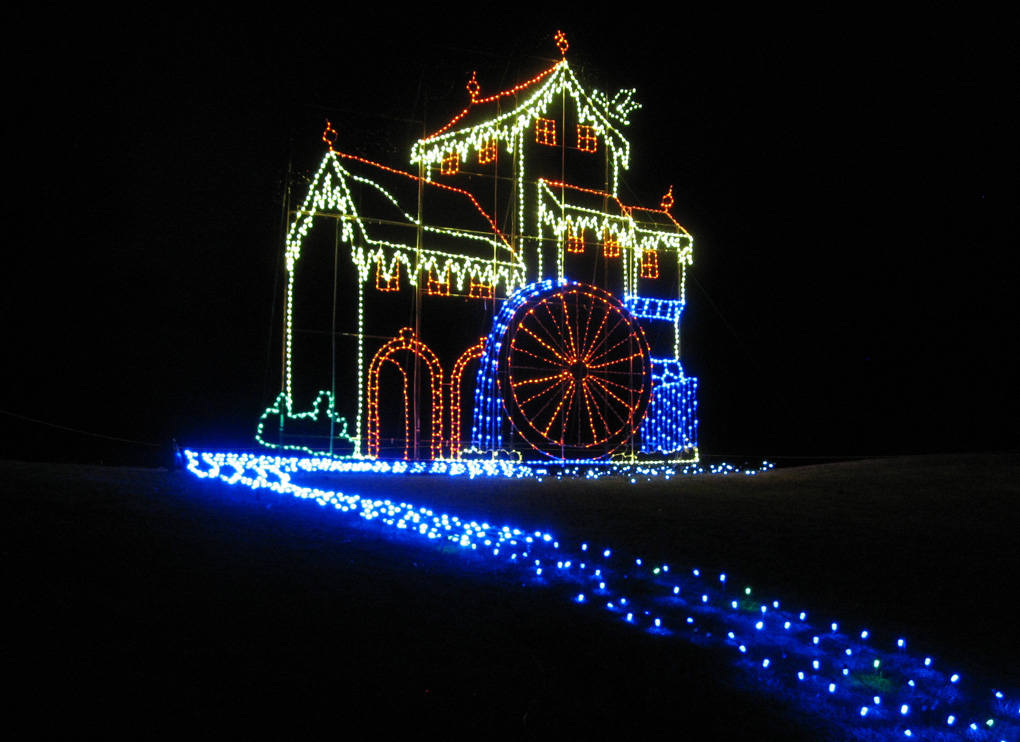
This mill with the stream of blue lights is a nice touch.
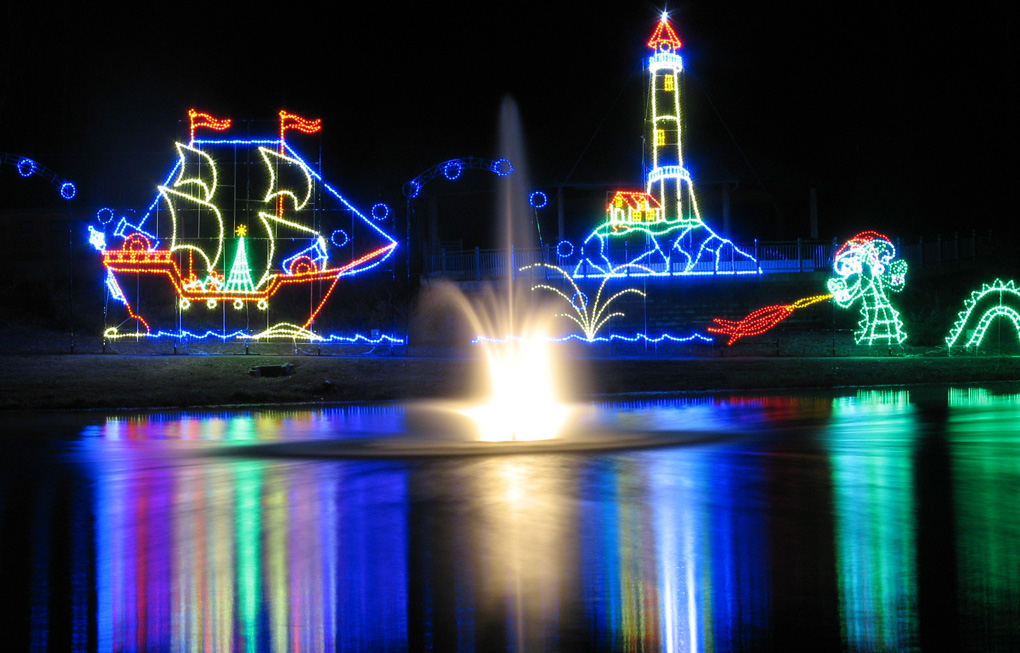
The real showpiece is the display around this pond — though you have to admit there’s not a lot of holiday imagery happening here.

OK, so the sea serpent may represent our collective dread of fighting crowds at the mall.
Why does the serpent seem to have two heads and three tails? In real life, the display flashes in multiple positions to give the impression that the serpent’s head and tail are moving. Actually the brain is what makes us think it’s animated. It doesn’t move at all — so when you leave a camera’s shutter open for 15 seconds as I did here, the sensor captures all the “frames” of the display’s animation and freezes them all in the same shot.

Ever notice how certain clowns, dolls and jack-in-the-box heads seem vaguely diabolical? It struck me as uncanny how this display has the same effect.
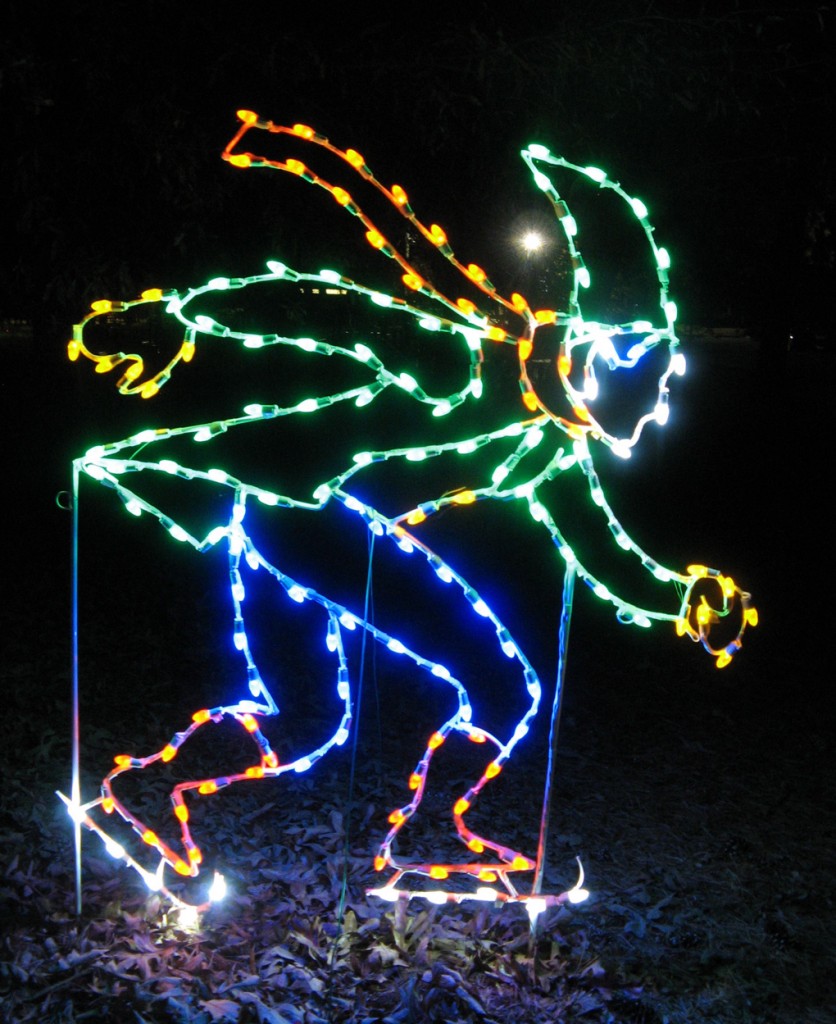
One of the many static displays.
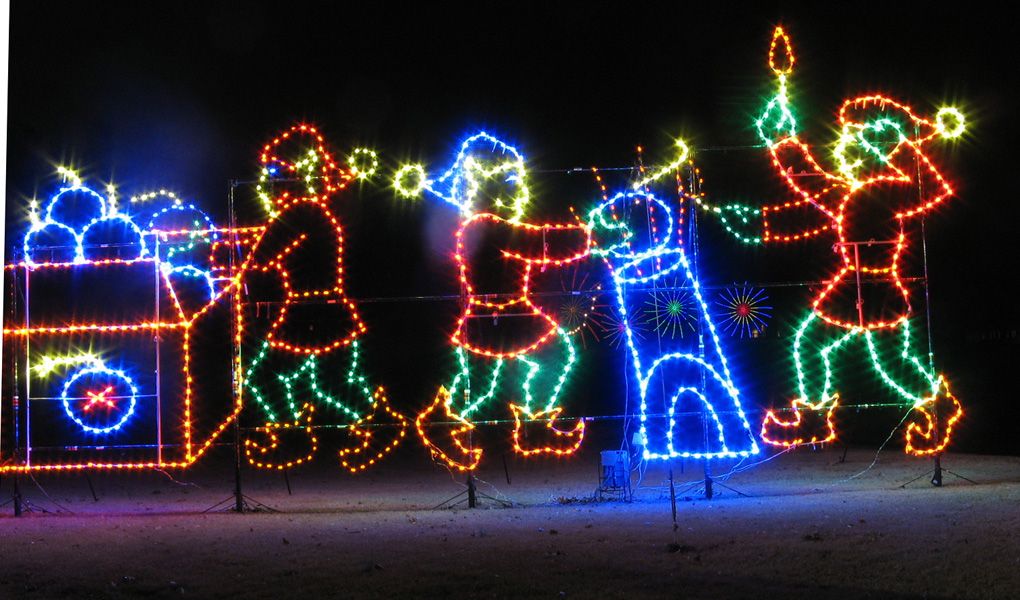
In the animation, the guy on the left is grabbing the time bombs from the box and handing them to the guy in the center, who drops them in the cannon for the guy on the right to light the fuse. The time exposure captures it a single frame.
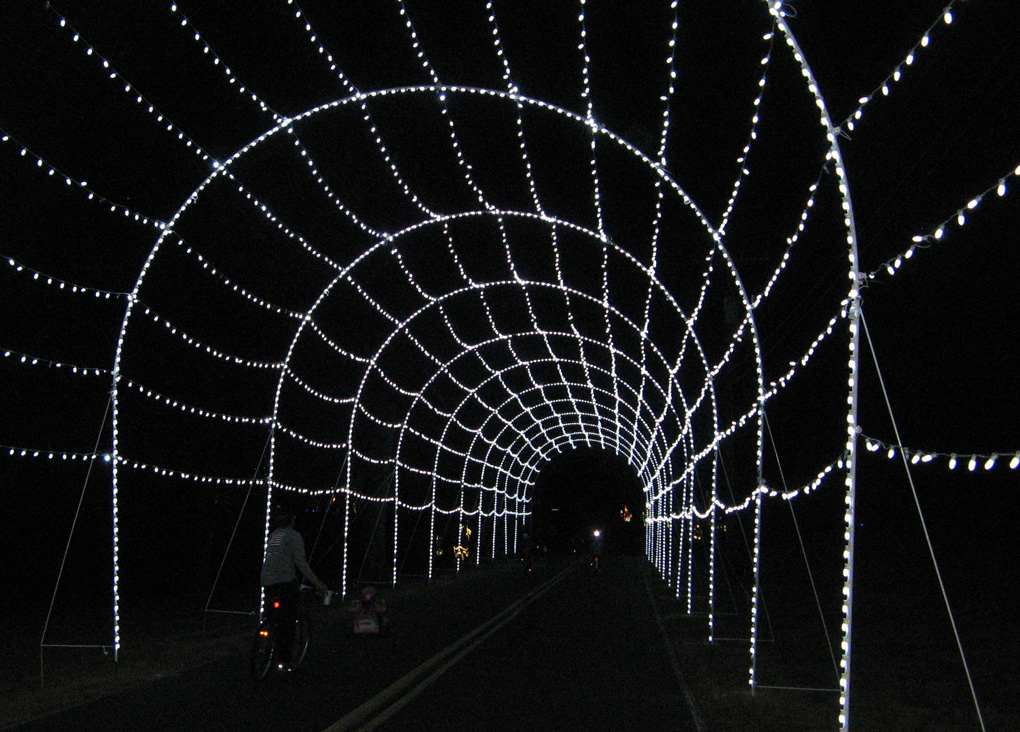
And now we jump to hyperspace! This actually is better experienced in the car because it makes your Chevy feel like a spaceship.
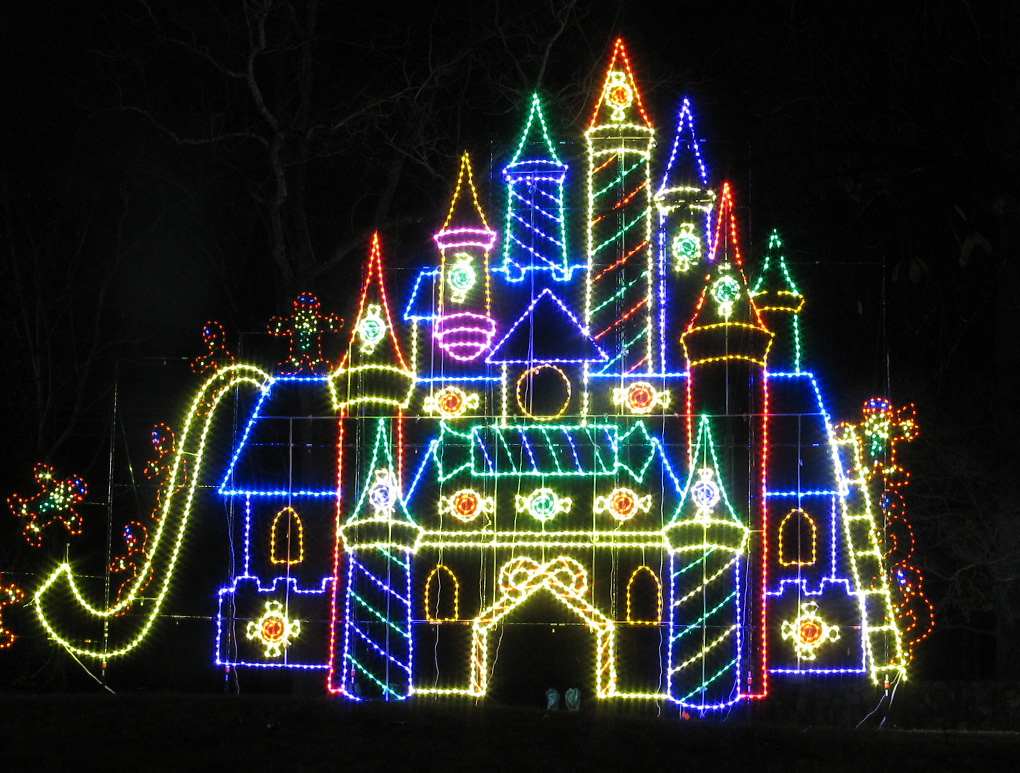
A magic castle.
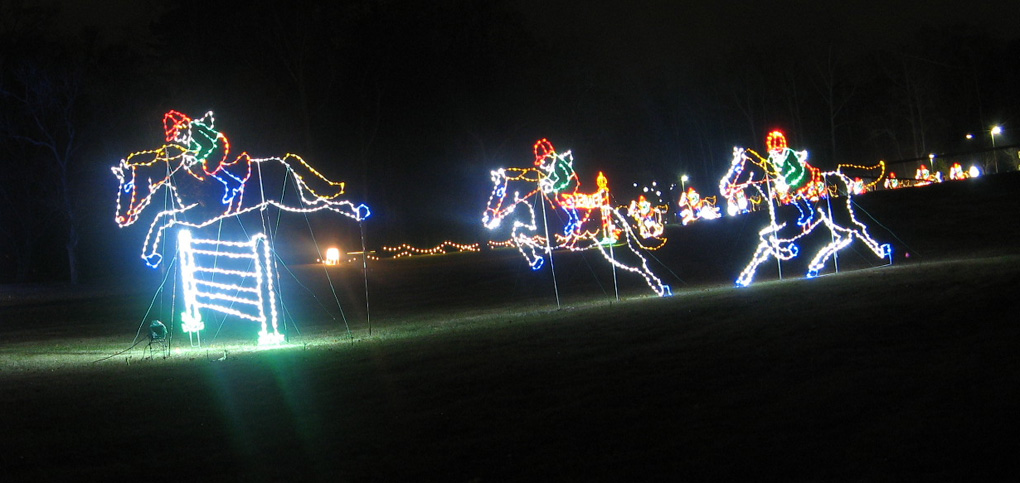
Horses leaping near an equestrian corral where people put their jumping horses through their paces.
More on the 2013 Festival of Lights.
- Official website.
- Schedule: 6 to 11:00 p.m. nightly, Nov. 23-Jan. 1.
- Fees: $20 for cars, trucks and SUVs on Friday-Sunday and all holidays; $15 on Mondays-Thursdays. See the website for rates on buses and commercial vans.
The post Pictures from Tanglewood Festival of Lights 2013 first appeared on Tom Mangan, Verb Nerd.
Some fall color at Tanglewood park 2 Nov 2013 12:52 PM (12 years ago)
A smashingly pleasant autumn morning practically begged me to take a stroll in Tanglewood Park and see how is autumn is shaping up (or down, it being fall and all).
Here are some of the images I bought home.

This bit of arachnid architecture was above our parking lot. I wondered how cold that spider must’ve gotten overnight.
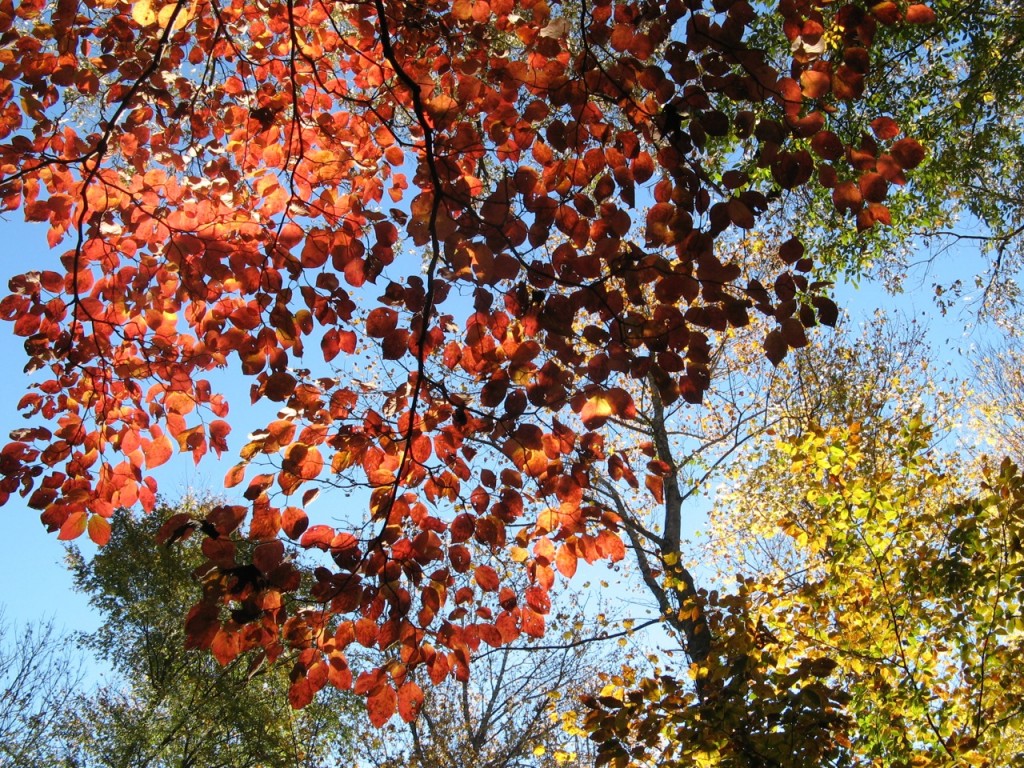
Tanglewood does not get the kind of fall color that looks awesome from a distance. The farther away you get, the more gray/brown/blah it looks. But up close, it can be pretty bright and shiny.

I won’t bore you with the gray/brown parts — so these pics might make the park look notably more colorful than it actually is. In any case the leaves will all be gone in a couple weeks anyway.
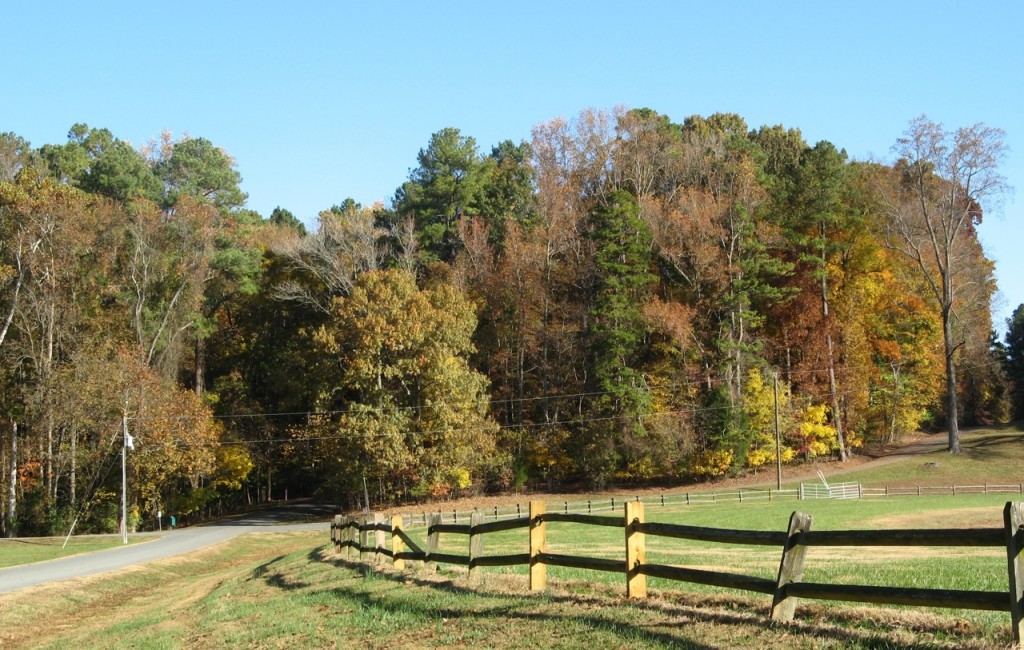
This shot illustrates the point — the woods have a lot of pine trees that never lose their leaves, plus a lot of species that have already shed theirs, a few in full color and a few that have not turned yet. So, from a distance, not super colorful. But the observant shutterbug is never daunted by such details.

The kids on the playground seem to appreciate the change in scenery.

This chapel — site of weddings every weekend in spring summer and early fall — is always good for a photo op.

This is about as bright as gets in Tanglewood. This more bush than tree but it definitely puts on a show.

This one tree has an impressive range of reds, oranges and yellows.
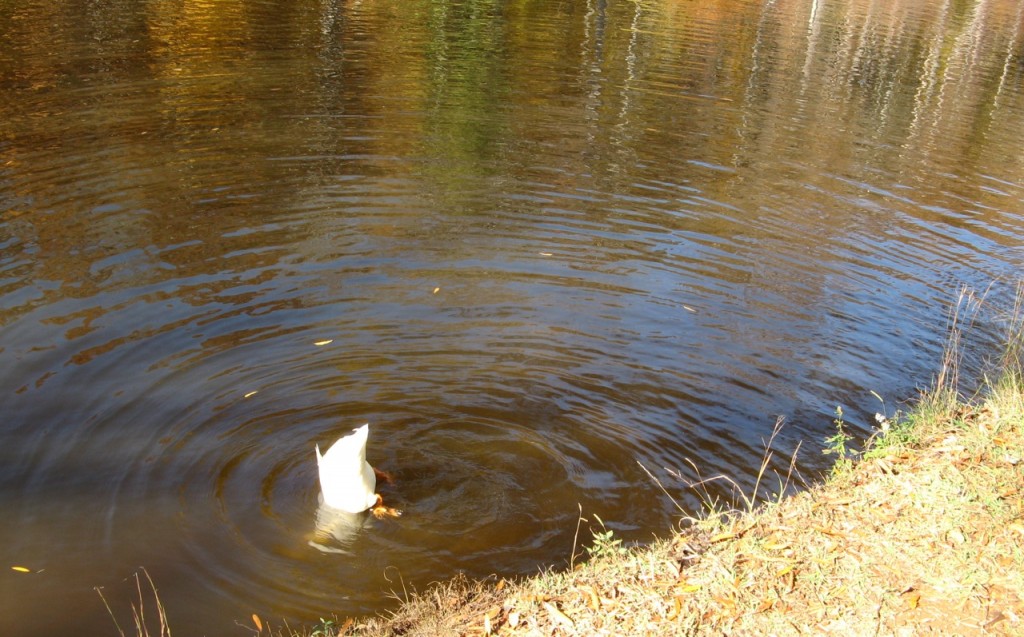
Over at Mallard Lake, local fauna demonstrate the inspiration for the DA hair-cut of the 1950s.
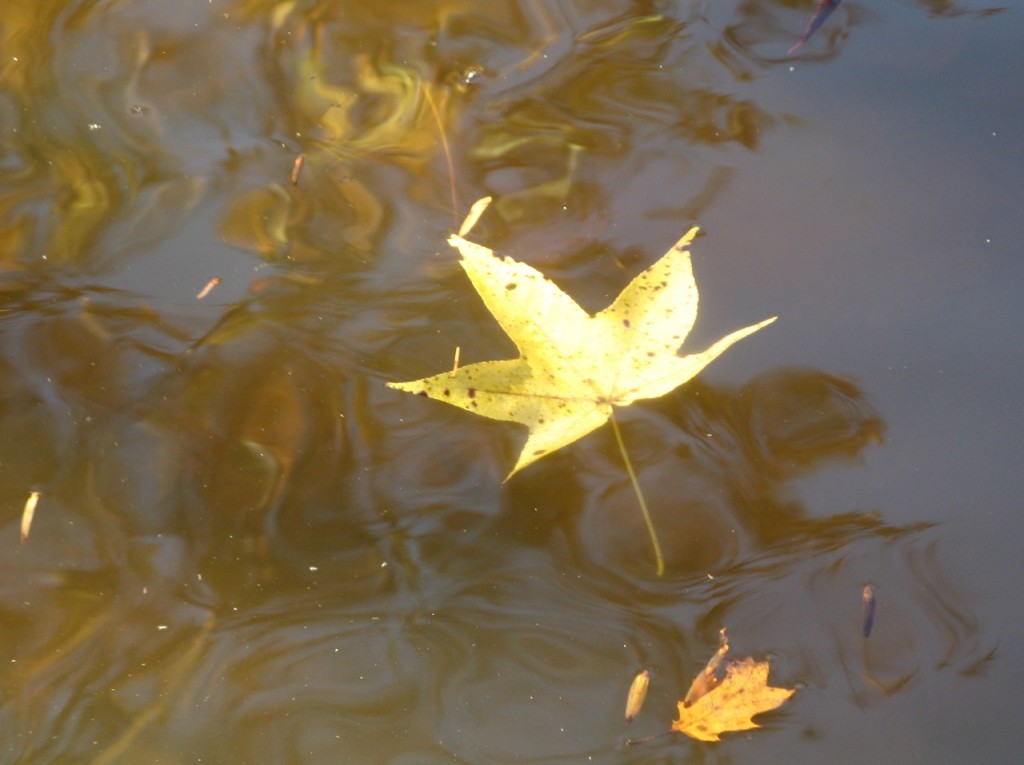
This leaf been attached to the tree only moments before.
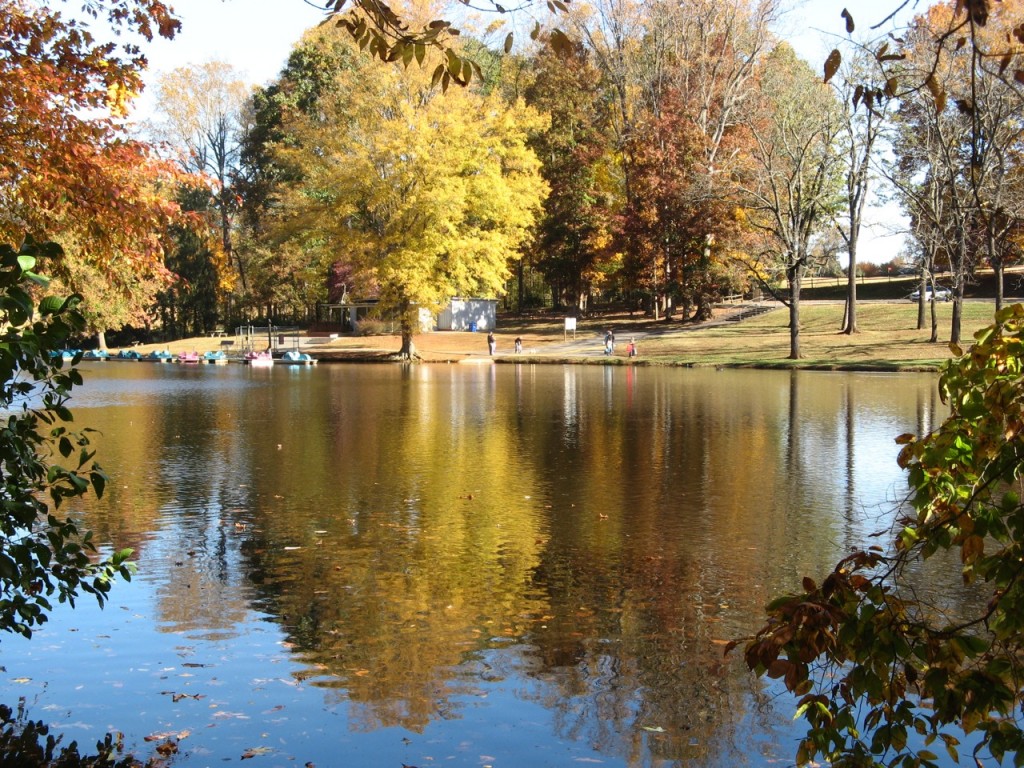
Mallard Lake is quite scenic if you take the trail through the woods on the shore opposite the developed area.
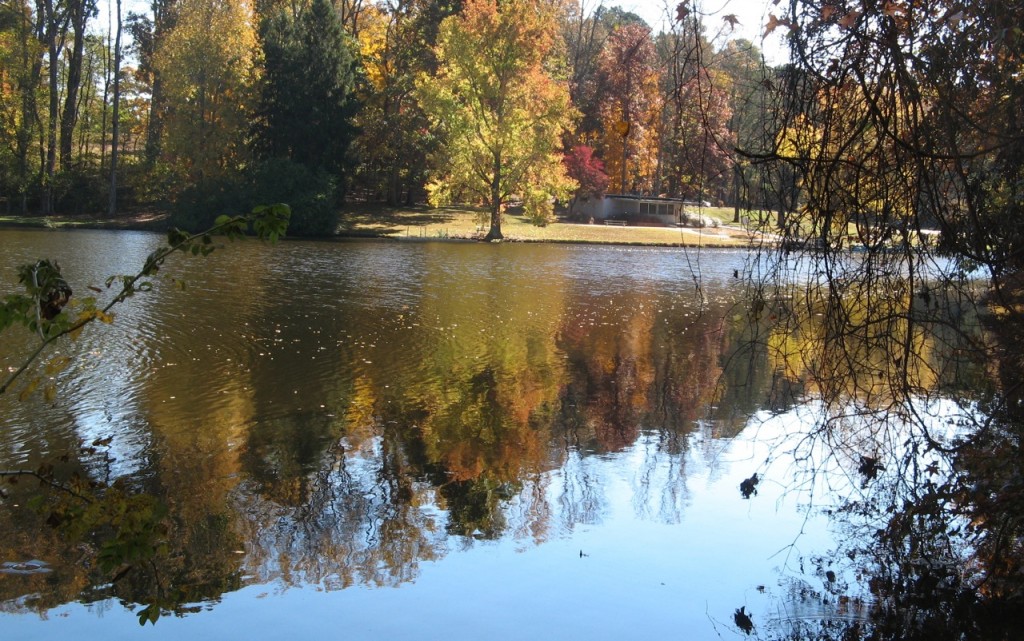
A nice reflection on the surface of Mallard Lake.
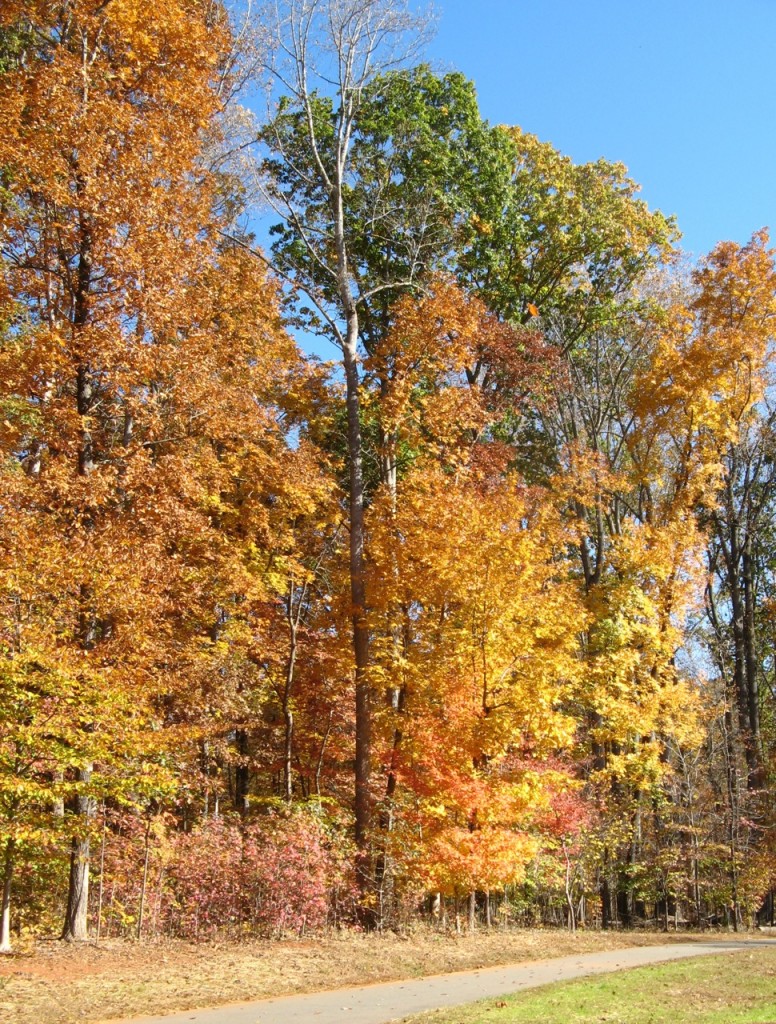
Tanglewood’s asphalt trail had some of the brightest color in the park.

Leaves doing what they do at this time of year.
The post Some fall color at Tanglewood park first appeared on Tom Mangan, Verb Nerd.
Latest hike: McAfee Knob 11 Jul 2011 5:51 AM (14 years ago)
 Sunday morning found me on the Appalachian Trail in Virginia just west of the Roanoke metro area. It’s a great moderate hike to one of the most famous places on the AT. The fame attracts sizable crowds, so I suggested the best times to go to beat the crush. Read the whole story at Two-Heel Drive.
Sunday morning found me on the Appalachian Trail in Virginia just west of the Roanoke metro area. It’s a great moderate hike to one of the most famous places on the AT. The fame attracts sizable crowds, so I suggested the best times to go to beat the crush. Read the whole story at Two-Heel Drive.
The post Latest hike: McAfee Knob first appeared on Tom Mangan, Verb Nerd.
What I think of the Fourth of July 4 Jul 2011 4:36 AM (14 years ago)
It was the 12th of September in 2001, the day after the 11th, and I was driving to work to fill a newspaper with followups. I lived Alameda County, California, and every day I crossed a minor mountain pass and descended into the wall-to-wall sprawl of Silicon Valley at Fremont, a burb that became a city of 200,000 people.
It was the same view I’d seen a hundred mornings before, but this time it was different. As I wondered what could’ve possibly possessed those clowns to fly jetliners into skyscrapers, I didn’t see Silicon Valley’s smog-inducing sea of sameness. This time I saw an ocean of ingenuity in all those office parks: people designing faster microchips, gleaning the secrets of DNA, making manufacturers more efficient.
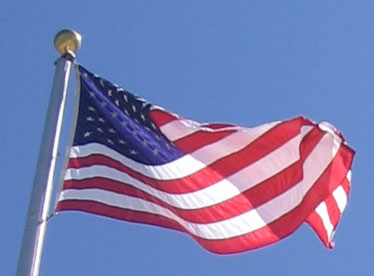 I’ll grant you those 19 guys were clever, daring and devoted to a cause. And there probably were thousands more just like them scattered around the globe. But they were outnumbered 50-to-1 in Silicon Valley alone, and the Silicon Valley types were building stuff, not blowing it up.
I’ll grant you those 19 guys were clever, daring and devoted to a cause. And there probably were thousands more just like them scattered around the globe. But they were outnumbered 50-to-1 in Silicon Valley alone, and the Silicon Valley types were building stuff, not blowing it up.
The lesson of human history is that the builders keep building and the bomb-throwers get blown up. That was the world I saw that morning on my way to work.
In America, we build. Not just houses, factories and fast-food joints. We build ourselves.
We’ve gotten ourselves into terrible jams in the 235 years since the Founders signed the Declaration of Independence. A Civil War, a Great Depression, two World Wars. Today gutsy young Americans are dodging bullets on our behalf, just as they’ve done in all our wars.
I’m not into simplistic, flag-waving patriotism that hollers “my country, right or wrong.” Everybody loves their country, which makes us all easy prey for politicians who’d use our affection for our homeland to fight their ill-advised wars. I’m even a little embarrassed by fireworks when I think of all the people who’ve huddled in bomb shelters as American-made rockets rained down on their neighborhoods.
Yeah, the history books are full of our nation’s screw-ups. We owned slaves, we wiped out Indian tribes. Up until about 1965, liberty meant “you’re free if you’re white.”
Two generations later, descendants of slaves are among our most popular personalities, and our president is a half-African with “Hussein” for a middle name. Try to imagine another country with 300 million citizens where that could happen.
We were the country that dumped monarchy into history’s landfill. We proved that people could elect their own leaders and build a productive, prosperous society despite all the divisions — religion, ethnicity, class — that bedevil us. Making racism obsolete will be our gift to the world. We’re not there yet, but it seems doable.
Update (summer 2013): When I wrote this in the summer of 2011, my prospects looked grim: 49 years old with no job and a home-based business built mainly on a suspicion that I could make it work. Today I have a thriving freelance content business that makes me proud to be an American on this Fourth of July — because impossible is still doable here.
The post What I think of the Fourth of July first appeared on Tom Mangan, Verb Nerd.
Top 10 reasons to hire a hiker 28 Jun 2011 9:56 AM (14 years ago)
The wilds of capitalism require a lot of skills that hikers take for granted. Among the habits we’ve acquired while walking in the woods:
There’s never only one way to climb a mountain, cross a stream or camp out for the night. There’s only the way that makes the most sense right now and further down the trail. How I hiked a trail last week is irrelevant if a 1,400-pound tree is blocking the trail today.
2. We don’t ignore what’s obvious to our senses
Hikers have to change our minds when the prevailing winds tell us we’re going south when we should be going north. We listen for distant thunder and prepare for rain as it gets closer. We stay off hilltops in electrical storms.
3. We don’t fear getting lost because we know how to get found
Hikers train themselves to watch for signs of wrong turns, pay attention to critical landmarks along the way, and have a turn-back plan in place if the trail we seek doesn’t show up on schedule.
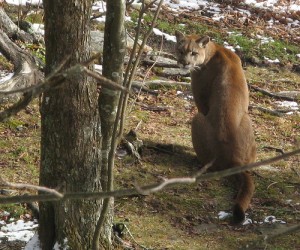 4. We manage risk
4. We manage risk
Hikers know there are extreme dangers in the woods — snakes, bees, bears, mountain lions — but we also know the odds of these dangers hurting us are extremely remote. The most pressing dangers on a hike are falling, getting lost and succumbing to hypothermia. So we watch our footing, carry our maps and first aid kits, and make sure we’ve got enough gear to get us through a cold night in the countryside.
5. We respect balance
Hikers appreciate nature’s uncanny knack for nipping here, tucking there, and generally working things out elegantly and efficiently.
6. We embrace change
We never hike the same trail twice, even if it’s the 20th time on the same route. We watch for subtle shifts in the landscape because we know they are inevitable.
7. We don’t mind working up a sweat
Hikers crave the exhilaration of navigating a tricky scree field and huffing it to high summits. We know that difficulty is often what makes something worth doing.
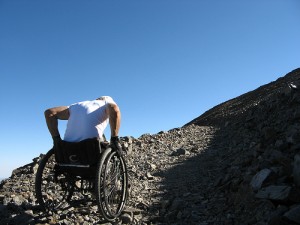 8. We have strength of body and spirit
8. We have strength of body and spirit
It’s not just the quads built up on 13 percent grades or the cardio capacity elevated by 13 miles above 12,000 feet. It’s the character we build by setting a goal, crafting a plan and getting it done.
9. We travel light
We leave our baggage at home, take only what we need, and make do with whatever fits into our pack.
10. We look after our own
Hikers help each other. We warning passing hikers of washed-out sections of trail. We give backpackers rides into town. We send for help. We build karma with kindness.
The post Top 10 reasons to hire a hiker first appeared on Tom Mangan, Verb Nerd.
My name is Tom, and I am a Verb Nerd 10 May 2011 6:36 PM (14 years ago)
 It used to be easy to explain how I earned a living. Just show somebody the daily scandal sheet and point to the headlines, captions, photos of a proper proportion, etc. All that ended a couple summers ago when I left the San Jose Mercury News by the back door for the last time.
It used to be easy to explain how I earned a living. Just show somebody the daily scandal sheet and point to the headlines, captions, photos of a proper proportion, etc. All that ended a couple summers ago when I left the San Jose Mercury News by the back door for the last time.
Today I’m doing something similar yet altogether different. I still write, I still edit, I never stopped blogging (it was easier to kick nicotine). I call my new venture Verb Nerd Industries — the link leads to several pages of shenanigans I’ve been implicated in over the years. My life story at a glance:
1961: Born in Peoria, Illinois.
1968: Moved to suburbs of Peoria with family (yes, Peoria had suburbs).
1979: Graduated from Limestone High School (see “Dazed and Confused”; it tells all of our stories).
1982: Lived in Abilene, Texas; assistant-managed a fast food joint called Hot Dog Castle, acquiring sufficient motivation to better myself.
1984: Entered journalism school at Southern Illinois University at Carbondale. Worked for campus paper called the Daily Egyptian, which was at least 10,000 miles from the Nile.
1988: Started first big-city newspaper job at the Tampa Tribune. Learned the true meaning of sweat.
1991: Married Melissa, next-door neighbor of the guy at the desk next to mine at the Trib.
1993: Moved back to Peoria to work for the Journal Star. Career highlight: compiling a package of stories revealing that the all the rich and famous Peorians got that way after moving away.
1996: Started my first blog, devoted to journalists’ websites. Didn’t realize it was a blog until years later.
1999: Moved to Silicon Valley to see the great Tech Boom up close. Tech Bust ensued as if on cue. Followed all the fun from the front lines at the San Jose Mercury News.
2005: Started Two-Heel Drive, my hiking blog; persisted all these years despite persistent evidence that bloggers rarely hike, and hikers rarely blog.
2009: Second market crash in the space of a decade motivated me to try new things outside the newspaper business. Relocated to North Carolina for the abundance of cheap housing and hiking trails.
2011: Launched Verb Nerd Industries. Avalanche of clients currently poised on a cornice somewhere in the Grand Tetons. Hire me now and beat the crush.
The post My name is Tom, and I am a Verb Nerd first appeared on Tom Mangan, Verb Nerd.
Where to find out what I’ve been up to 19 Nov 2010 6:07 AM (14 years ago)
When I’m not noodling with my various blogs, I’m often killing brain cells at these online hangouts:
I was geeky enough to snag facebook.com/thomasmangan before somebody else did.
Twitter was a mildly diverting toy till I discovered a site called Paper.li, which allows you to create an online newspaper from the links posted to Twitter. Now I have four tweets-papers:
- Tom Mangan Daily: Roundup from all the people I follow on Twitter.
- Triad Tweets: News & culture links from the Triad region of North Carolina.
- Hiking & Outdoors Afternoon Update: Cool links for people who like to play in the woods.
- Outdoor Gear Morning Update: Gear news for folks in the trade.
I’ve posted dozens of iPhone hiking guides and GPS-enabled travelogues there.
Work history and recommendations from colleagues.
The post Where to find out what I’ve been up to first appeared on Tom Mangan, Verb Nerd.
My movie thing 11 Sep 2010 7:41 AM (15 years ago)
I’ve been a movie junkie as long as I can remember. I recall ripping through the TV section of the Peoria Journal Star every Saturday, looking for hopeful signs on the next week’s movie horizon. I couldn’t have been older than 9 or 10, with tastes appropriate to my years — all I needed in life was two hours of Godzilla eating Tokyo or Washington fending off alien invaders.

I watched everything back then — I still remember the first time I saw Slim Pickens riding that A-bomb to his doom in “Doctor Strangelove.” I had no idea it was a comedy.
Oddly enough, the late-show movie most fixed in my memory involved a black guy trapped in a mine while World War III breaks out. He escapes to a world devoid of people and settles into a strange life in a vacant New York City. Then he finds a woman. Things progress until another guy shows up. He’s white. Naturally, the first instinct of the last three people on earth is a racially charged love triangle.
Today my movie habit is enabled almost entirely by Netflix.com, and my deepest lament is that I’ve seen all the good ones (nearly 1200 titles and counting).
Netflix doesn’t stock every film ever produced (they’re not all out on DVD), but it has enough to keep a fiend like me on the hook. I’ve become a huge fan of foreign flicks, mainly because gobs of great movies are out there if you can deal with the subtitles (I’d rather read subtitles than try to watch dubbed movies; the mouth-not-following-the-words is too distracting).

I’ve seen all the best work of Akira Kurosawa, Japan’s legendary film director. His “Seven Samurai,” remade in the U.S. as “The Magnificent Seven,” tells the story of lowly Japanese peasants who become so fed up with marauding bandits that they hire free-lance samurai warriors to a) save their crops; and b) seek revenge. One of the co-stars is Toshiro Mifune, who also starred as a cunning rogue who plays a town’s feuding factions against each other in the classic Yojimbo, remade as “A Fistful of Dollars” in the spaghetti western that turned Clint Eastwood into a huge star.
Speaking of samurai warriors, thanks to Netflix I stumbled across the work of Jean-Pierre Melville, a great French director whose Le samouraï” was one of the great crime movies of the 1960s. Le samouraï features a square-jawed heartthrob who carefully and precisely kills people for a living. Even better is “Le deuxième souffle” (The Second Wind), featuring a scary-tough bad-ass (hard to imagine in a French film, I know) named “Gu” who breaks out of prison and attempts the epic heist that will let him retire in peace.
I could go on, perhaps to my last keystroke, raving about all the great movies and griping about the bad ones. It’s true they don’t make them like they used to. But good ones keep getting made, and forgotten ones keep getting rediscovered.
Fine time to be a film fiend, no doubt about it.
The post My movie thing first appeared on Tom Mangan, Verb Nerd.
Combining two of my favorite things 18 Apr 2010 6:46 PM (15 years ago)
Funny how necessity recalibrates your intentions. Back in California I’d do almost anything to avoid long drives to trails — it seemed like a crime against nature to spend more time driving than hiking. The reality, though, was there were so many excellent hiking trails in the Bay Area that I could always find an excuse to pair a long hike with a short drive.
On our current end of the country, the situation is almost entirely reversed: it’s crazy to make do with local trails when excellent ones are just a couple hours away. Case in point: Saturday’s hike at Grayson Highlands State Park paired five hours of driving with five hours of hiking. While the Appalachian peaks seem scrawny by Western standards, they are nevertheless mountains that stretch for 1,200 miles from Georgia to Canada. There’s nothing like it within 50 miles of Winston-Salem.
The route up to Grayson Highlands twists, climbs and dives though at least 50 miles of remote two-lane blacktop; I’ve always loved taking these kinds of drives. Seems I now have two reasons to head for the hills.
(I’m sure it’s just a coincidence — not karma or anything — that my luck seems to have been continually improving since my departure from the daily-dose-of-doom industry.)
The post Combining two of my favorite things first appeared on Tom Mangan, Verb Nerd.
Scene from my morning walk 19 Mar 2010 7:06 AM (15 years ago)
This is the Yadkin River, taken from Tanglewood Park. Used my iPhone camera.
The post Scene from my morning walk first appeared on Tom Mangan, Verb Nerd.
